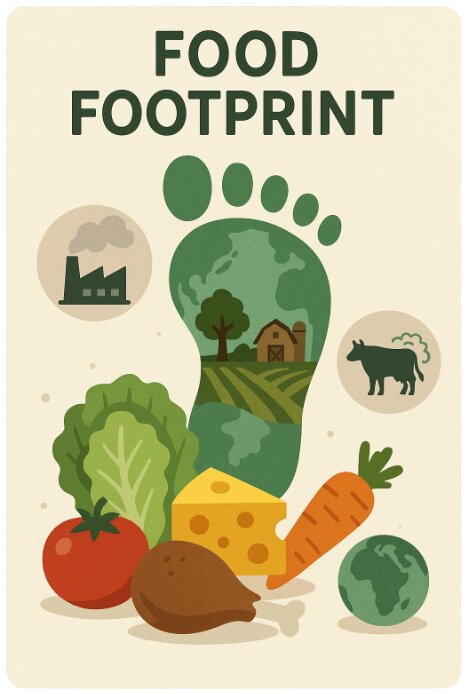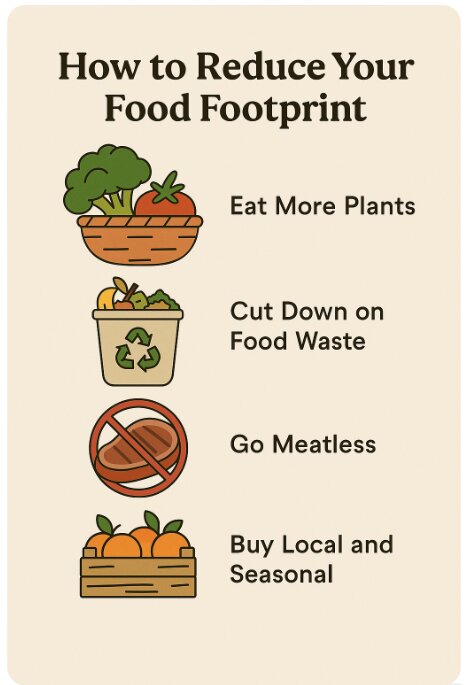What Is a Food Footprint? Easy Ways to Reduce Yours Today
Most of us have heard the term “carbon footprint” before. We might think about our car trips, plane rides, or electricity use. But what about our meals? Have you ever taken a moment—mid-bite—to ask yourself what it actually took to get that burger, salad, or smoothie onto your plate?
The truth is, most of us don’t. And it’s not our fault. We’re used to thinking about food in terms of taste, cost, or calories. But behind every bite, there’s an invisible story of environmental impact—and that’s what we call a food footprint.

In This Article
- What Is a Food Footprint?
- The Carbon Cost of Our Food
- Water Use and the Hidden Thirst
- Water Use and the Hidden Thirst
- Food Waste: The Invisible Footprint
- Practical Ways to Reduce Your Food Footprint
- What Governments and Corporations Can Do
What Is a Food Footprint?
A food footprint (also called a dietary or carbon foodprint) is the environmental impact of everything on your plate—from the farm to your fork. It includes the greenhouse gases released during farming and transport, the water used to grow your food, the land it takes up, and even what happens if it goes to waste.
And here’s the surprising part: our food choices are one of the biggest ways we shape the planet. A major 2023 report by the Food and Agriculture Organisation (FAO) found that food systems are responsible for over 30% of total human-made greenhouse gas emissions globally, with livestock alone contributing more than 11%. That means how and what we eat plays a major role in climate change.
Components of a Food Footprint
- Carbon Footprint: Emissions of CO2, methane (CH4), and nitrous oxide (N2O) from agriculture and food transportation.
- Water Footprint: Volume of freshwater used to produce food.
- Land Footprint: The Amount of land used for crops or livestock.
- Waste Footprint: Impact of food loss and waste.
The Carbon Cost of Our Food
Some foods contribute significantly more to greenhouse gas emissions than others. Understanding these differences is crucial for making environmentally conscious decisions. Based on the comprehensive study by Poore and Nemecek (2018), which analysed data from over 38,000 farms across 119 countries, the greenhouse gas emissions associated with various food items have been updated as follows:
| Food Item | CO₂e Emissions (kg per kg of food) |
|---|---|
| Beef (beef herd) | 99.5 |
| Lamb & Mutton | 39.7 |
| Cheese | 23.9 |
| Pork | 12.3 |
| Poultry | 9.9 |
| Tofu | 2.0 |
| Lentils | 0.9 |
| Tomatoes | 1.1 |
These figures highlight the significant environmental impact of animal-based foods, particularly beef, which has the highest emissions per kilogram. In contrast, plant-based foods like lentils and tofu have substantially lower greenhouse gas emissions, making them more sustainable dietary choices.
Case Studies: Reducing Emissions Through Dietary Changes
Hannah Ritchie, a senior researcher at Our World in Data and a climate data expert, shared her own journey of changing her diet to cut emissions. After analysing her carbon footprint, she decided to cut out beef and lamb entirely and focus on plant-based meals. She didn’t become fully vegan but prioritised low-impact proteins like legumes and eggs.
“The single most effective way I’ve reduced my emissions is by changing my diet,” she said in her Our World in Data blog. “By cutting beef alone, I reduced my food-related emissions by over 50%.”
Her experience shows you don’t need to be perfect—you just need to be aware. Small, consistent choices can add up to a huge impact.
Recent research from the George Institute for Global Health in Australia demonstrates the tangible benefits of simple dietary adjustments. By substituting red meat with chicken or plant-based alternatives and choosing tomato-based sauces over creamy ones, households can significantly reduce their greenhouse gas emissions. For example, replacing 1 kg of beef mince with chicken weekly can save more than two tonnes of CO₂ annually. These changes not only benefit the environment but can also lead to healthier dietary patterns.
Similarly, a study led by Stanford University found that making straightforward food swaps—like opting for plant-based milk over dairy or choosing poultry instead of beef—can reduce an individual’s dietary carbon footprint by over 35%. Such modifications are practical and can be seamlessly integrated into daily routines without drastic lifestyle overhauls.
Learn More: 10 Ways the Fast Food Industry Impacts the Environment and Climate Change
Water Use and the Hidden Thirst
Water is another often-overlooked resource in our diets. Producing just one kilogram of beef requires approximately 15,415 litres of water. In contrast, the same amount of potatoes needs only about 287 litres. This huge difference highlights the substantial water resources consumed by certain foods, particularly animal products.
Understanding these figures is essential, especially in regions facing water scarcity. By making informed dietary choices, individuals can contribute to more sustainable water usage.
Here’s a quick comparison of the water footprint for various common food items:
| Food Item | Liters of Water per kg |
|---|---|
| Beef | 15,415 |
| Cheese | 3,178 |
| Rice | 2,497 |
| Wheat | 1,608 |
| Apples | 822 |
| Potatoes | 287 |
Source: Water Footprint Network
Water Use and the Hidden Thirst
Vast areas of land are cleared to grow feed crops or graze livestock. This contributes to deforestation, biodiversity loss, and land degradation. The World Wide Fund for Nature (WWF) reports that agriculture is the leading cause of deforestation, especially in the Amazon.
A significant example is soy production. While soy is a high-protein crop with a relatively low water footprint, over 75% of global soy production is used to feed livestock, not people. This indirect consumption contributes to deforestation, particularly in regions like the Amazon and the Cerrado savanna. In 2024, the Cerrado experienced higher deforestation rates than the Amazon, largely driven by soy cultivation.
Recognising the environmental impact, companies are adjusting their sourcing practices. For instance, Danone ceased sourcing soy from Brazil in 2024 to comply with upcoming European Union regulations aimed at preventing imports linked to deforestation.
Food Waste: The Invisible Footprint
It’s startling to realise that nearly one-third of all food produced globally is wasted. This wastage contributes to 8–10% of global greenhouse gas emissions, a significant environmental concern highlighted by the United Nations Environment Programme (UNEP).
Reflecting on my own habits, I used to discard wilted spinach weekly, not considering the broader impact. Over time, this seemingly minor waste added up to over 20 pounds of food per month. Considering that each kilogram of food waste can emit approximately 2.5 kg of CO₂ equivalent, this amounted to roughly 150 kg of CO₂e annually, just from my leftovers.
This personal experience points toward a larger issue. In 2022, households were responsible for 60% of the 1.05 billion metric tons of food wasted globally, averaging about 79 kilograms per person per year. This level of waste not only squanders resources but also exacerbates climate change.
Practical Ways to Reduce Your Food Footprint
1. Eat More Plants
Transitioning to a plant-based diet is one of the most effective ways to lower your food-related environmental impact. Even modest changes, like replacing one beef meal per week with lentils, can make a difference. Dr. Joseph Poore from Oxford University highlights that if everyone adopted a plant-based diet, global farmland use could decrease by 75%, freeing up land for nature and carbon absorption.
2. Buy Local and Seasonal
Choosing local and seasonal produce reduces the need for long-distance transportation and storage, thereby lowering greenhouse gas emissions. For instance, asparagus flown in from South America has a carbon footprint 28 times higher than locally grown asparagus. Supporting local agriculture not only benefits the environment but also strengthens community economies.
3. Reduce Food Waste
Food waste contributes significantly to greenhouse gas emissions. To combat this:
- Plan Meals: Create shopping lists and stick to them to avoid overbuying.
- Proper Storage: Store food correctly to extend its shelf life.
- Embrace Leftovers: Incorporate leftovers into new meals.
Utilising frozen produce can also help, as it’s often wasted less than fresh alternatives.
4. Compost Food Scraps
Composting is a simple yet effective way to reduce methane emissions from landfills. Studies show that composting food scraps results in 38% to 84% fewer greenhouse gas emissions compared to landfilling. Additionally, compost enriches soil, promoting healthier plant growth.
5. Choose Low-Impact Proteins
Opting for proteins with lower environmental footprints can make a substantial difference. Consider incorporating:
- Tofu
- Lentils
- Chickpeas
- Eggs (in moderation)
These alternatives require fewer resources and produce fewer emissions than beef or lamb.
6. Support Sustainable Brands
Purchasing from brands committed to sustainable practices encourages environmental responsibility. Look for certifications such as:
These labels indicate adherence to environmentally friendly and ethical standards.

Learn More: What are the Most Sustainable Foods?
What Governments and Corporations Can Do
Policy Shifts
Governments can implement several strategies to promote sustainability:
- Carbon Labelling on Food Packaging: Introducing carbon footprint labels on food products can empower consumers to make environmentally conscious choices. Companies like Oatly and Quorn have already adopted such labels, providing transparency about the environmental impact of their products.
- Subsidies for Sustainable Agriculture: Providing financial incentives for sustainable farming practices encourages farmers to adopt methods that are better for the environment. The USDA’s Sustainable Agriculture Research and Education (SARE) program offers grants to support such initiatives.
- Food Waste Reduction Programs: Implementing programs to reduce food waste can significantly decrease environmental impact. The USDA’s Composting and Food Waste Reduction cooperative agreements fund projects aimed at minimising food waste and promoting composting practices.
Corporate Responsibility
Corporations are also taking steps toward sustainability:
- First Milk: This British dairy cooperative operates the largest regenerative farming program in the UK dairy industry. First Milk has committed to reaching net-zero emissions by 2040, with interim goals including sequestering 100,000 tonnes of CO₂e per year on farms by 2025.
- Nestlé: Nestlé is working to implement regenerative agriculture practices across its supply chains, focusing on improving soil health and reducing greenhouse gas emissions.
- Tesco: The UK-based retailer is investing in vertical farming to grow crops like strawberries indoors year-round, reducing carbon emissions and water usage while increasing yield. Tesco is also trialling low-carbon fertilisers with suppliers, which have shown potential to cut emissions by up to 50%.
However, transparency and accountability are crucial. Watchdog organisations emphasise the importance of third-party audits to ensure that corporate sustainability claims are substantiated and that genuine progress is being made.







